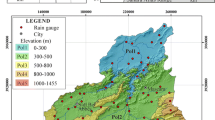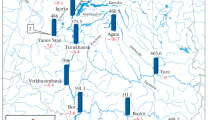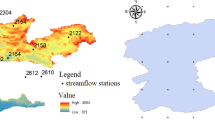Abstract
Based on the monthly meteorological data at 58 meteorological stations from 1971 to 2000 in the Longitudinal Range-Gorge Region (LRGR) and the surrounding areas, six factors including yearly ET 0, maximum monthly ET 0 (May), minimum monthly ET 0 (December), paddy irrigation quota and total agricultural irrigation quota (yearly and main irrigation period from April to June) were selected to examine their spatial variability using a geostatistical approach. The results indicated that the coefficients of Moran’s I, describing the intensity of spatial autocorrelation, were greater in longitudinal direction than in other directions; the spatial variabilities of the six parameters were mainly caused by structural factor accounting for 60.2%–87.9%; the largest variabilities of ET 0 (yearly, in May and December) appeared in the northwest-southeast and northeast-southwest directions. Due to the summer monsoon atmospheric circumfluence from the Indian Ocean and the Pacific Ocean, and continental warm-dry current in winter, the minimum fractal dimension and the maximum spatial variability of ET 0 (yearly, in May and December) occurred in southwest-northeast and southeast-northwest directions. The highest variabilities of paddy and total agricultural irrigation requirements occurred in the south-north direction due to the vapor and energy diffusion caused by corridor function of the longitudinal rivers. The minimum spatial autocorrelation was in east-west direction, which proves that the six parameters of agricultural irrigation requirement were influenced by the “corridor-barrier” function in the LRGR and its surrounding areas.
Similar content being viewed by others
References
He D M, Wu S H, Peng H, et al. A Study of ecosystem changes in Longitudinal Range-Gorge Region and transboundary eco-security in Southwest China. Adv Earth Sci (in Chinese), 2005, 20(3): 338–344
He D M, Liu C M, Yang Z F. Study for the sustainability of international rivers in China. Acta Geogr Sin (in Chinese), 1999, 54(Suppl): 1–10
He D M, Feng Y, Gan S, et al. Transboundary hydrological effects of hydropower dam constructing on the Lancang River. Chin Sci Bull, 2006, 51(Suppl): 16–24
Feng Y, He D M. Research progress on international rivers in Asia. J Geogr Sci, 2006, 16(3): 271–276
Wu S H, Dai E F, He D M. Major research perspectives on environmental and developmental issues for the Longitudinal Range-Gorge Region (LRGR) in Southwestern China. Prog Geogr (in Chinese), 2005, 24(1): 31–40
Feng Y, He D M, Gan S, et al. Linkages of transboundary water allocation and its eco-thresholds with international laws. Chin Sci Bull, 2006, 51(Suppl): 25–32
Gu S X, He D M, Li Y H, et al. Influence of “corridor-barrier” function on water demand of paddy irrigation in the Longitudinal Range-Gorge Region. Chin Sci Bull, 2006, 51(Suppl): 9–15
Li Y H. Theory and Technology of Water Saving Irrigation (in Chinese). Wuhan: Wuhan University of Hydraulic and Electric Engineering Press, 1999. 47–64
Allen R G, Pereira L S, Raes D, et al. Crop evapotranspiration: Guideline for computing crop requirement. FAO Irrigation and Drainage Paper No.56, Rome, Italy. 1998, 51–202
Clarke D. CropWat for Windows: User Guide. University of Southampton, England. Oct. 1998, 1–40
Guo Y Y. Irrigation and Drainage Engineering (in Chinese). Beijing: China Water and Hydropower Press, 1998. 28–74
Gu S X, Li Y H, Cui Y L, et al. Irrigation Water management software development state and prospect. J Irrig Drain (in Chinese), 1999, 18(1): 61–64
Zhang R D. Spatial Variability Theory and Application (in Chinese). Beijing: Science Press, 2005. 23–88
Dai E F, Wu S H, Li S C, et al. Spatial variability on vegetation parameters in Longitudinal Range-Gorge Region. Chin Sci Bull, 2006, 51(Suppl): 1–8
Yuan X, Li E Y. Spatial variability of Crop reference evapotranspiration. J Hudraul Eng (in Chinese), 1990, 20(2): 33–37
Yan J F, Chen X, Luo G P, et al. Temporal and spatial variability response of groundwater level to land use/land cover change in oases of arid areas. Chin Sci Bull, 2006, 51(Suppl 1): 51–59
Wang J L, Sun J S, Zhang J Y, et al. Crop water requirement isoline based on GIS and geostatistics. Transactions of CSAE (in Chinese), 2004, 20(5): 51–54
Duchemin B, Hadria R, Erraki S. Monitoring wheat phenology and irrigation in Central Morocco: On the use of relationships between evapotranspiration, crop coefficients, leaf area index and remotely-sensed vegetation indices. Agr Water Manage, 2006, 79(1): 1–27
Fu B J, Yang Z J, Wang Y L, et al. A mathematical model of soil moisture spatial distribution on the hill slopes of the Loess Plateau. Sci China Ser D-Earth Sci, 2001, 44(5): 395–402
Zhao B, Cai Q H. An application of geostatistcal analysis in freshwater ecosystem. Acta Hydrobiol Sin (in Chinese). 2000, 24(5): 514–520
Gan H H, Peng L Y. Spatial valiability of nutrients in cultivated soils in Xinhui District, Juangmen City. Chin J Appl Ecol (in Chinese), 2005, 16(8): 1437–1442
Tao Y, Zheng J M, Wang Y X, et al. Evolution feature of the rainy season onset time of Yunnan Province. Climate and Environ Res (in Chinese), 2006, 11(2): 229–235
Gan S, He D M. Analysis on morphological character of Longitudinal Range-Gorge Region based on Geo-informatic Tupu method. J Yunnan Univ (in Chinese), 2004, 26(6): 534–540
Zhou C H, Wu S H, Dai E F, et al. Vapor corridor phenomenon and response of vegetation NPP in Longitudinal Range-Gorge Region. Chin Sci Bull, 2006, 51(Suppl): 97–107
He D M, Wu S H, Ou X K, et al. Progress in ecosystem changes in Longitudinal Range-Gorge Region and transboundary eco-security research. Acta Geogr Sin, 2007, 62(1): 93–100
Cao J, He D M, Yao P. Research on the spatial distribution of rainfall and temperature in winter and summer over Longitudinal Range-Gorge Region (LRGR). Adv Earth Sci (in Chinese), 2005, 20(11): 1176–1182
You W H, Duan C C, He D M, et al. Climatic difference in dry and wet season under effect of the Longitudinal Range-Gorge and its influence on transboundary river runoff. Chin Sci Bull, 2006, 51(Suppl): 69–79
Author information
Authors and Affiliations
Corresponding author
Additional information
Supported by the National Key Project for Basic Research of China (Grand No. 2003CB415105)
About this article
Cite this article
Gu, S., He, D., Cui, Y. et al. Spatial variability of irrigation factors and their relationships with “corridor-barrier” functions in the Longitudinal Range-Gorge Region. Chin. Sci. Bull. 52 (Suppl 2), 33–41 (2007). https://doi.org/10.1007/s11434-007-7004-6
Received:
Accepted:
Issue Date:
DOI: https://doi.org/10.1007/s11434-007-7004-6




